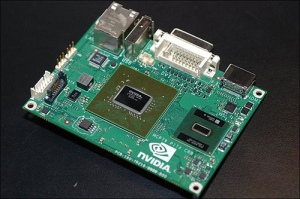NVidia’s ION Reference Platform

Nvidia ION Reference Board
There is a great deal of heat and light surrounding the soon-to-be-competing NVidia ION platform, and Intel’s Atom platform. What makes this a curious “co-opetition” battle is that the ION platform utilizes an Intel Atom 330 processor, but chucks the Intel integrated graphics chipset, replacing it with their own Nvidia 9400M.
Some high-level background can be found at:
http://gigaom.com/2009/01/29/with-ion-nvidia-covers-the-mobile-market/
and:
http://www.nvidia.com/object/sff_ion.html
Up to now, everyone seems to be focusing on the Atom platform as strictly a “Netbook” play — e.g., the microscopic laptops one sees from Acer, Eee PC, et. al. NVidia’s take is that consumers of these devices would like to play Crysis and play Blu-Ray discs, too. While I’m sure many would, I don’t think top-end-gaming will decide this market.
That being said, I’m no fan of Intel’s current graphics hardware. To call it inadequate for many current tasks would be an insult to the word “inadequate”, resulting in calls from “inadequate”‘s lawyers. So I won’t. I’ll just wait for Larrabee see if the video memory bandwidth on this graphics solution is also… thin. There is good reason for hope, but that’s subject of another post.
I think the real, killer applications for this “small-form-factor” platform are going to be atypical devices — not clamshell laptops writ small. Think about home theater devices that could benefit from the advanced processing power. When you buy a $4000 LCD HDTV, most of what you’re paying for is the advanced video processing — it’s actually very hard to get typical, interlaced, compressed, broadcast video to look good on an LCD panel. GPUs have the necessary processing power to run the most advanced image and video processing functions. Settop boxes could definitely use a low-cost GPU, in my opinion, for multiple reasons.
This also extends to many other consumer electronic applications, and even professional, very specialized equipment. Why spend $35MM NRE on developing a custom ASIC chip for a piece of test equipment, when one of these ION platforms has a good processor (Intel Atom 330), and a ripping, multi-multi-core, high-memory-bandwidth processor (Nvidia 9400M), and an industry standard IO bus capable of high throughput (PCIe 2.0)? Who needs an ASIC, if there’s a low cost commercial, off-the-shelf board, with all the memory, processing, and IO you need, and it costs less in quantity?
I suspect that history will record that the ION/Atom platform skirmish is really the first shot in the Intel Larrabee/NVidia GEForce M battle. — and not because of Netbooks — it will be because of the hundreds of other devices and applications that can make use of this type of platform.
